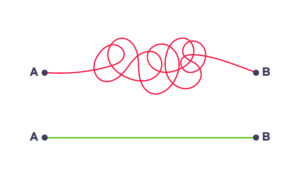Forgiveness is a loaded word for most of us and there are many situations that seem (or are) unforgiveable. But ongoing anger is deadly and is even more so in the presence of chronic pain. You are really trapped and the depth of your frustration is indescribable. It is at the core of being in The Abyss.
The word carries such deep meaning that it is more useful to reframe it as just one aspect of “anger processing.” Forgiveness specifically addresses input into your nervous system that results in a heightened state of alert (output).
Processing anger has three components: 1) Input – what are you holding on to and what are you choosing to load into your nervous system? 2) The state of your nervous system – is it hypervigilant or calm? 3) The output – the final makeup of your body’s neurochemistry. Are you full of stress hormones and inflammation or relaxation hormones and anti-inflammatory chemicals?
The final output changes every second and is the result of the interaction between your stresses and capacity to deal with them. When your stresses overwhelm your coping capacity, your body’s physiology will create many different physical and mental symptoms. Holding onto anger is a major reason your body will remain on high alert and eventually it will break down. The final goal of processing anger is to bring your body (output) back into a state of feeling relaxed and safe.
The sequence of becoming angry is:
- Circumstance or person who has wronged you (real or perceived)
- Blame
- Victim
- Anger
Anger is so powerful that no one ever wants to let it go. Becoming aware of this universal unwillingness to move on is a critical step. Being a victim is a strong role, and it helps you feel safe, whether you are or not. You are never going to wake up one day and feel that you want to give it up. You must keep making an ongoing choice to let go.

The next step is becoming aware when you are in a victim role. There are many disguises. Unfortunately, this hyper-vigilant neurochemical state (manifested by anger) shuts down the rational frontal cortex of your brain and your glial cells (support system for neurons) throw off inflammatory markers, which sensitizes your nervous system. This cascade of events blocks access to being open, having insight, treatment and healing.
You simply have to decide whether you want to remain in this role or move on. There is no magic or shortcuts. It is an ongoing intellectual choice of, “I don’t want to continue being a victim.” One term for this decision is, “flipping the switch.”
Levels of forgiveness
At its most basic level forgiveness is simply “cutting the cord” and letting go. This is different than “acceptance” and “suppressing.” It is an intellectual decision you make every time your attention lands on an upsetting spot. That is it and all that is necessary to free yourself from the past. You have definitively altered the input.
A deeper level of forgiveness would be seeing the situation through the other party’s eyes and have some understanding of where he or she is coming from. This will allow you let go a little more.
Developing compassion for the other person is what a lot of people consider forgiveness. You realize that there is a high chance that they are suffering and the reason they acted badly. But it may be essentially impossible to achieve, especially if there is ongoing abuse. It is not necessary to reach this level to effectively process anger.
Processing anger is a learned skill and an ongoing daily process without a beginning or endpoint. It is a powerful statement to you and the world that you are going to live your life on your terms, and no one person or situation is going to take that away from you. It is the tipping point of healing in that you cannot create the necessary shift in your brain to move on without letting go of the past.

Methods of changing the input
There are many aspects of addressing what you are holding onto from the past and forgiveness has many facets to it. I learned many of these following concepts from Dr. Fred Luskin, who is a friend of mine and author of Forgive for Good. (1) Some suggestions include:
- Understand how detrimental it is to hold on to the past and not live in the present. Dr. Luskin calls this scenario “renting too much space in your mind.”
- Just “let go.” Is this person or situation worth disrupting your day and peace of mind?
- Reframe the situation. Make a choice not to view yourself as a victim and look at challenges as opportunities. “Never waste a crisis.”
- Cultivate awareness—just being aware of your anger can dissolve it. Especially when you realize that it exists only within you.
- Identify your grievance stories—Dr. Luskin also makes the observation that if you tell the same story more than three times where you are the victim, you have a “grievance story.”
- This is particularly relevant when suffering from chronic painwhen it really was someone else’s fault. How long do you want that person or employer to run your life? They are not worth your time.
- “The unenforceable rules”—There are many situations and people in life that you wish would be different, but you have no control or say. It is fine to want a better scenario, but when that wish turns into a mental demand, it is problematic. Spending time being upset about things you have no control over is a complete waste of time.
- Have compassion—I mention this gingerly because this step is difficult and not mandatory to move on. Most people, including me, can’t achieve this without professional help. What about compassion for yourself?
Please just don’t read this list. Processing anger is a learned skill set that requires ongoing daily practice. Forgiveness is an important aspect of it. Eventually, it becomes easier and somewhat automatic.
Essentially every person I have seen truly heal has learned to recognize and process his or her anger. Although you can improve without dealing with it, the real breakthroughs won’t happen without letting go and it often happens quickly. Each person is different and will learn these skills at his or her own pace. However, we have observed that letting go of anger is so powerful, we call it “the shortcut to healing.”

References:
- Luskin, Dr. Fred. Forgive for Good. Harper One, New York, 2003.
